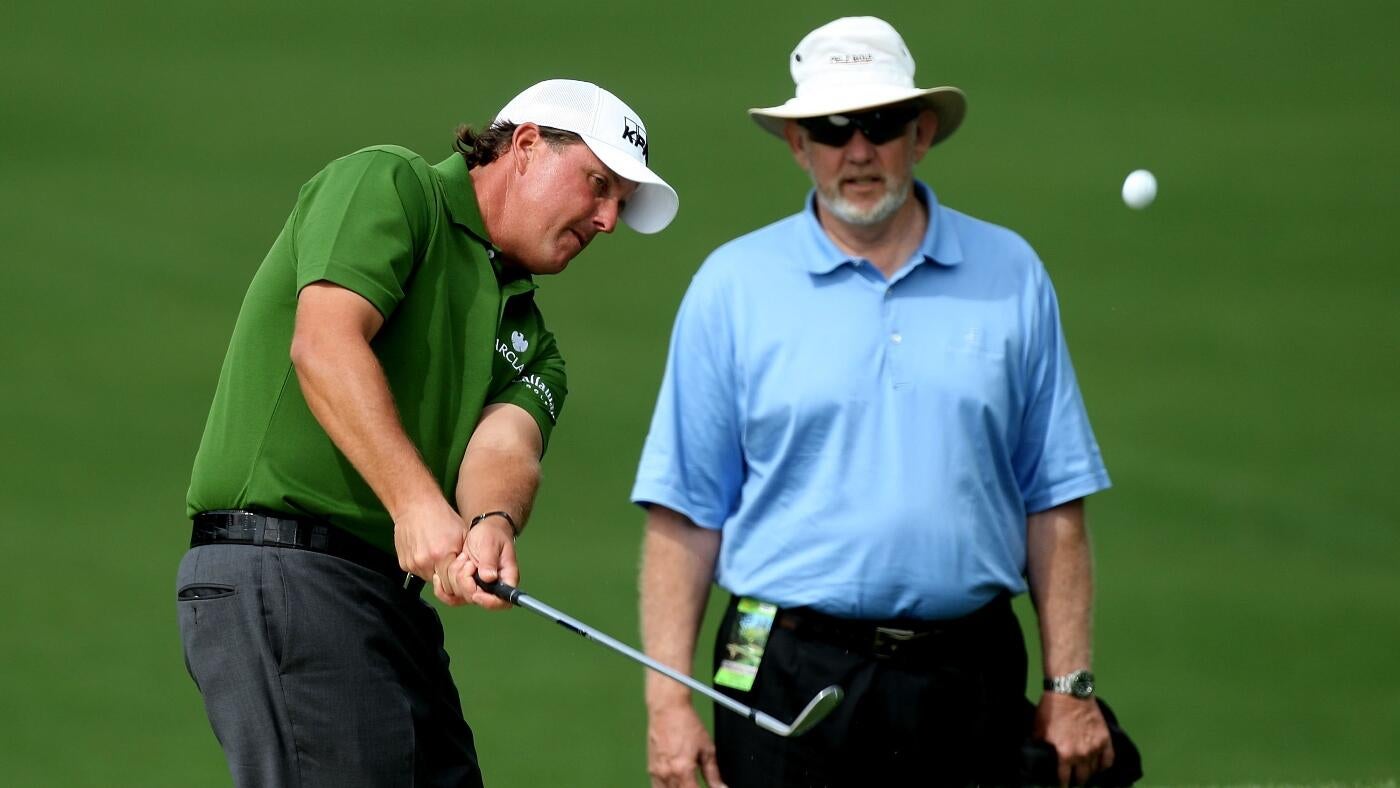In 1974, Dave Pelz was visiting Kenya of all places, laying on one of its white sandy beaches, when he made a life-changing decision.
For more than a decade, he had studied planetary atmospheres and ran satellite programs as a senior nuclear physicist during the golden age of the space race for the National Aeronautics and Space Administration’s Goddard Flight Center outside of Washington, D.C. But his hobby of clinically measuring what happens when a putter head hits a ball was absorbing more of his time and interest. He became obsessed with calibrating speed and break in the greens, energy imparted to the ball when it was hit on the heel, toe and sweet spot of the putter. He built a two-pronged appendage to the face of his putter, framing the sweet spot. The device worked simply enough: Hit the prong and the ball deflected off course. Pelz took his new tool to the practice putting green and proceeded to miss the first 97 putts. But the 98th attempt, he stroked squarely and the ball rolled straight and true into the cup. That summer, he won his club championship.
Pelz concluded that putting mechanics had been totally neglected as a field of study. Good putters, the experts said, were born not made. His own experience in 1974 convinced him otherwise. Comforted by the assurance from his boss that he could take an educational leave of absence and still return to physics after a one-year trial in the putter business, Pelz made the plunge. He started working in the basement of his home and despite losing his investors’ money that first year, he determined there was no going back.
“I loved that year,” he told Golf for whom he served as the magazine’s longtime technical consultant. “Every minute of it was great. I was able to look past the money loss. I knew I could be successful; I was certain I could contribute something to the betterment of the game.”
Pelz resigned from NASA, mortgaged his home and two cars to fund his business and the game of golf has never been the same. He revolutionized how the game is taught, played, and understood. Pelz spent the next 50 years applying statistical research to golf instruction in his quest to help golfers shave strokes. He became golf’s resident short-game guru philosophizing on the importance of shots from 100 yards and in — nearly 80 percent of shots lost to par occur within that distance, he discovered — and focusing on practicing putting since it made up 43 percent of the game. He was ShotLink before ShotLink existed. With the brain of a renaissance man, he used his scientific background to develop a data-driven approach, computing the depth that most golfers could never grasp but had the gift of being able to communicate it in simple terms that a child could understand. He articulated his teaching methods via the written words in articles and in best-selling books, on informercials and The Dave Pelz Scoring Game Show, a long-running Golf Channel instruction show, at golf schools and to his pupils on the PGA and LPGA tours.
Pelz, whose name became synonymous with the words "short game," died on Sunday due to complications from prostate cancer at his home in Dripping Springs, Texas, his stepson, David Pelly, confirmed. He was 85.
Pelz waged a silent battle against the disease for many years. In the May 2019 issue of Golf, he went public with his fight, writing, that he had spent the past four years battling the disease but was cancer-free and had walked nine holes with pupil Patrick Reed at TPC Sawgrass during practice rounds at the Players Championship two days in a row for the first time in a while.
“I want to tell you just how great that feels,” he said.
Pelz was golf’s absent professor, dubbed "Professor Putt," a 6-foot-6-inch, teddy bear of a man in his trademark bucket cap, who spoke softly and sincerely. He was a pioneer in so many fields — from frequency matching shafts to founding the World Putting Championship — that compiling a list of what he didn’t do in golf may be shorter. In 1981, Tom Kite became the first player to carry a third wedge in his bag, which allowed him to be more precise with his distance control. Kite went on to lead the money list and win the Vardon Trophy for low-scoring average that season. The facility to produce higher, softer pitch shots around the green has made the 60-degree wedge one of the most important tools in golf.
Pelz developed more than 40 different training aids, including the Pelz Putting Tutor, that have helped golfers more quickly grasp the concepts he teaches for getting out of a bunker, for holing more putts and for chipping it close. In 1982, he opened his first short-game school in Abilene, Texas. His Dave Pelz Scoring Game School became the first clinics to concentrate exclusively on the short game and became so successful in Boca Raton, Fla., that it was expanded to Palm Springs, Calif., and Vail, Colo. By the late 1990s, it had grown to more than 40 schools and his acolytes continue to teach his methods to thousands of students every year.
"There is a misnomer out there that practice makes perfect," Pelz once said. "Practice does not make perfect. Practice makes permanent. It's sad, but there are thousands of golfers out there who are practicing the wrong things and are actually ingraining flaws into their swings.”
In 1982, Pelz introduced the Dave Pelz Featherlite golf clubs. In 1986, he left the manufacturing business, convinced his niche was in the area of research, development and education. But he held 20 different patents, including for the two-ball putter, which Odyssey licensed for $250,000. It went on to become one of the top-selling clubs, let alone putters, of all time, and changed perceptions of what a putter could look like.
“He cared more about lowering the handicap of a stranger in Des Moines, Iowa, than one of his major champions,” said Carl Mickelson, who handled marketing and public relations for Pelz Golf for 21 years, and remembered the time Pelz’s New York Times best-selling book “Short-Game Bible,” leaped past “Who Moved My Cheese.”
The Pelz stable of students – Kite, Vijay Singh, Andy North, his first major winner in 1978, Paul Azinger, Lee Janzen, Payne Stewart, Mike Weir, Beth Daniel, Jane Geddes, Michelle Wie, the list goes on and on – combined to win more than 20 majors. Just a few weeks ago, he met with Patrick Reed, the 2018 Masters champ, and helped him prepare for this year’s first major.
"He taught me how to think, how to listen, and he brought so much life to my game. Dave Pelz (DP) was and is the best coach I ever had," Reed said. "Everything he ever taught me holds strong and holds true, and it always will, because Dave didn’t back anything he wasn’t 100 percent sure of. He didn’t sway with the wind, he was the wind. Every time I ever met with him, he blew me away."
Pelz's most famous pupil was Phil Mickelson, who was winless in 43 starts at the majors when he contacted Pelz in late 2003. "I said, 'You've got to be kidding. You're already the best. Why do you want me?' " Pelz recalled on The Charlie Rose Show.
Mickelson said he wanted to shave one-quarter stroke per round off his average 18-hole score. His one-shot (per four rounds) request came because he had missed playoff opportunities in the majors by – you guessed it – one shot. It had happened six times. Anxious to shake the label of “best player to have never won a major,” Mickelson reasoned that if he could have scored one stroke lower in those six events, he would have won at least one playoff.
Pelz developed a computer program he dubbed “AEMAX,” an acronym for “Analyze your game, Eliminate your weaknesses, and Maximize your ability to score.”
“I’m just saying: he has won three green jackets and five total majors (now six) since adopting our strategy of ‘bomb it at the Masters, hit more accurate short shots everywhere else,’” Pelz wrote in a magazine column.
Mickelson was quick to credit the data Pelz had collected for improving his game.
“Dave found that the average bunker shot is 10 yards, so I practiced from that distance, and I went from 180th in sand saves in 2006 to third two years later,” said Mickelson, who again ranked third in 2016.
Pelz was born Oct. 8, 1959, in Willoughby, Ohio, and attended Indiana University on a golf scholarship, majoring in physics with minors in mathematics, philosophy and astronomy.
By the time Pelz left Indiana, he had compiled a perfect record against Nicklaus, his nemesis in dual matches, round-robins and Big Ten Conference meets.
"I was 0-22, but that wasn't so unusual," Pelz said. "Most people haven't beaten Jack Nicklaus."
Pelz never abandoned his scientific training, applying the scientific method, isolating variables, studying them independently. For 50 years, he woke up thinking about golf and never had an off switch.
"In the shower," his wife, JoAnn, said. "It's awful. I mean, everywhere. David's a very narrow person."
When he started counseling pros, 99 percent of them putted with a conventional grip and rejected the cross-handed style he preferred.
“If you did, you had given up. You had the yips,” Pelz said, referring to the involuntary loss of control that affects a player’s nerves on short putts.
From 1977 to 1980, Pelz tracked the putting of one of his pupils, Tom Jenkins, who had the worst putting stroke Pelz had ever measured at the time. Pelz’s charts, diagrams and graphs indicated that the journeyman pro putted better cross-handed. Jenkins would putt that way during practice rounds, but he always got cold feet and reverted to a conventional grip once the tournament began.
“Tom has a sensitive personality and people loved to tease him. But my research proves putting cross-handed is a more stable stroke. It levels your shoulders and allows you to follow through better,” said Pelz, who taught his sons to putt that way.
Eventually, Jenkins joined the converted and enjoyed the best years of his career.
“I can honestly say Dave Pelz saved my career as a professional golfer,” Jenkins said.
Pelz also built arguably the greatest backyard practice facility in golf in Austin, Texas. With greens that replicate those found at such iconic courses as Augusta National (including No. 12 and Rae's Creek), Pebble Beach (14th and 17th greens) and TPC Sawgrass (17th island green). Pelz's backyard laboratory also had a tee box for full shots that extends more than 400 yards.
“In the morning, I can come out here in my skivvies,” he said in 2019. “There's no one here. It takes me 38 seconds from the living room to have a wedge airborne. If I'm here, I can practice. If I had this 40 years ago, there's no telling how good I could've been.”
This coaching and testing ground allowed him and his Pelz Institute research team to carry on refining his theories and training techniques even in the final weeks of his life. He is survived by his wife, their five children, nine grandchildren, and a grateful golf community. Those who wish to share their thoughts or memories are invited to a special tribute page at www.pelzgolf.com/tribute/.
This article originally appeared on Golfweek: Dave Pelz, who was synonymous with the short game, died at age 85






